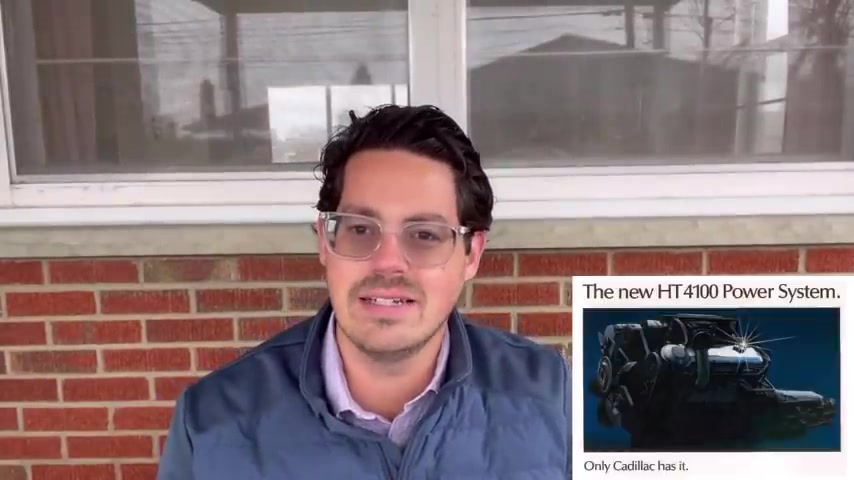https://www.youtube.com/watch?v=eaRLUyOSxgk
Worst Car Engines of All Time - GM

Well , hello and welcome to another Ports , chat on Rare classic cars .
It's a wonderful day in the winter in the Midwest here again .
So we're going to talk about a favorite topic that is going to be emotional for some folks .
Worst G M engines .
This is not in a rank order .
By the way , I think it's probably hard to rank worst things .
Um They're all bad but uh I won't say worst GM engines of all time either because I'm not all that familiar with their 19 8 power trains and things from back when they started .
But let's call it of that Malaise era 78 S period when GM unfortunately turned out quite a few stinkers when it came to the engines and the transmissions as well .
But this is my brief list and we'll start with the first one up there .

The Cadillac HT high tech 4100 engine .
Yes , the H T did stand for high technology .
Uh This engine came out in 1982 and it made all of a whopping 125 135 horsepower over its lifetime and it was rushed into production to meet cafe or the fuel economy standards .
And you can imagine having 125 135 horsepower engine in a £4000 plus car .
Not good .
So this poor motor was tasked with basically powering cars that it really wasn't designed for .
It was designed to be a part of the sea cars that came out in 1985 like the De Ville .
It was , it was supposed to be powering that and that sea car was supposed to come out before .
It was not supposed to be an 85 model year car .
It was supposed to be I think an 83 model year car originally , but that got delayed .

And then Cadillac really needed to help the company hit the fuel economy target .
So they dumped this ht 4100 engine in the large rear wheel drive cars .
And aside from it not being powerful , which was a challenge on its own .
This car was an aluminum block engine and a suit of iron if you will .
So the main philosophy was that all of the ware components that would experience ware would be made of iron , but the block would be aluminum .
So the cylinder head was iron .
It has cast iron cylinder liners .
G M had learned from another engine that's on here , the Chevy Vega engine to make sure that you have some sort of a cylinder liner , at least if you're G M and , but the problem with this motor was a number of things .

The first I would say is this mixed metal strategy of the aluminum block , iron had aluminum intake coupled with GM , really trying to get away from gaskets to save cost and using RTV to seal off different passages and as a proxy for gasket .
So R TV , you have to have absolutely clean surfaces and you know , when you have metals expanding and contracting at different rates , aluminum and iron don't expand and contract at the same rates .
So imagine you got the aluminum intake , an iron head and aluminum block , all expanding and contracting really at different at different rates with one another .
As the motor warms up or cools down , it's tough to keep that sealed .
And so these cars , in addition to other issues like soft cam shafts , they also just suffered from typically blowing the intake gasket .

Then that would cause the oil to mix with the coolant that would chew up your bearings and your cam shaft and your crank shaft and then the car would overheat as well , then it would blow the head gasket .
These had a ton of problems so many .
So the Cadillac had to actually create a power train warranty just for these that extended beyond the typical bumper to bumper warranty to reassure customers that they would , they would fix the motor if it had any issues .
But you know , those these engines , I would say , I think that the issue of being mixed metals coupled with being dumped in really heavy cars .
You know , it's cold out .
Customers would go start up their car , it's cold , they go pull out on the main road while the motor isn't warmed up and probably to floor it to get up to speed , which just puts unnatural stresses and strains internally on the motor and causes more of the issues that we were just talking about .

So , really , really , um especially in the early years , 1982 to 1985 they did do some redesigns in 85 through 87 to improve the motor , but it just wasn't , it wasn't really a good one to have .
Now , in spite of this , I will say I've owned about four cars with that motor and I've never had any problems with them , but you have to do a couple things , do not push the motor .
First of all , these motors aren't strong and the transmissions that often back them like the 4 40 T four are not strong either .
So don't push the motor hard drive it normally second when it's cold , let the motor warm up before you accelerate with any sort of alacrity at all .
I used to always drive mine like I had an egg under my foot until it went up to operating temperature .
And then third , you have to change the coolant relatively frequently .

I change mine every 2 to 3 years and you must use four , the GM ceiling tabs , which are basically the bars leaks those pellets you need to use that .
That is factory service procedure on these .
It also is for the early north stars too , by the way , and that has its own issues leads to sometimes clogged heater cores .
But you must follow those procedures when , if you want these motors to live and I will say they're reliable until they aren't until they have a catastrophic failure .
I've had them as daily drivers .
They do get really good mileage .
I have an 84 Seville that routinely gets 24 25 MPG freeway .
I had an 85 Deville that would get 26 25 26 on the freeway .
So they do deliver good mileage .
And in the , excuse me , in the downside , front wheel drive , sea bodies , they're actually pleasant .

They're very smooth and I will also just say , don't buy one with high miles .
All the ones that I've had have low miles in general .
The lifetime of that motor is , I would say 100,000 miles .
Yes , there are people who get more out of them , but I wouldn't budget much beyond that .
They , like I said , they did have often soft cam shafts and the , the water pumps weren't very good .
That would also cause overheating the coolant fan modules on the front wheel drive cars weren't that reliable .
So that would cause overheating and try to get one if you're going to get one with low miles and just budget for you may have challenges .
Although I will say I never have second Oldsmobile V eight diesel , both the 352 61 cubic inch .

I noticed I didn't say the old V six diesel which came out in 1982 but the old V eight diesel was essentially a gas engine , an old 350 cubic inch motor that General Motors took and diesel for lack of a better term and rushed to market again to meet the cafe standards .
We've talked about that in another video and it was underdeveloped in a number of areas .
I would say most prominently , the head bolts were not strong enough in the early years .
In particular , the GM for cost reasons , didn't have water separators or ways to eliminate the water filter out the water in the fuel very well and diesel fuel attracts moisture quite readily .
So most every diesel engine before since has some sort of a water separator system and diesel fuel during that time in the US just also wasn't that great a quality .

So you can imagine water is not compressible .
So that's a bad thing .
And you don't want water getting into the injector pump and it seals the injector pumps also had some issues .
But I would call those relatively minor in the grand scheme of things compared to the head bolts and the lack of a water separator .
And again , the car wasn't that powerful .
It was 100 those motors were 105 to 120 horsepower again , in £4000 cars plus often .
And I think again that , you know , people start those up , went on the main road floored , it put a lot of stresses on all those head bolts that were undersized , blew the head gaskets .
Not good .
Now , the later ones when they came up with what's called , the D X block were a bit better .
Um , but I would say the 1978 79 model year ones in particular are somewhat troublesome .
And I think people also didn't like to turn the key on and wait to start .
Albeit by 79 they had fast working glow plugs .

So I had a 79 civil diesel actually was my daily driver .
And even if it were zero degrees outside , you turn the key on , you'd wait six or seven seconds and it was ready to start .
And I never had an issue , but I always drove it gingerly until it warmed up and I changed the oil .
Frequently , oil and diesel gets really dirty really quickly .
And just as an insurance policy , I was frequently changing my oil probably every couple 1000 miles and the car was reliable .
I never had any problems with it .
I think a lot of people pushed the maintenance interval on the oil change as well .
It didn't have an oversized oil filter .
It was just a standard P F 24 whatever the GM used during the time .
So , again , not a great one .
And that motor was also standard in the 1980 Cadillac Seville .
So two Cadillac motors on the bad list here in a relatively short period of time .

And there's going to be another one that we'll get to the third , the Chevrolet Vega 2.3 liter , especially from before the 1976 Mali or when it was rebranded , I believe the Dura built Dura something I think it was Dura built .
But again , another aluminum block this time with no cast iron cylinder liners had a cast iron head .
It was an overhead cam engine but aluminum does not wear nearly as well as cast iron .
Cast iron is much more rigid .
Cast iron is a phenomenal material you have graphite in , in basically the iron or carbon precipitates that make it self lubricating .
So when it's under stresses that graphite and the carbon that is an alloying element of it is helpful to provide anti wear .
And for this engine GM tried to have a coating , a silicon coating to try to eliminate or reduce the wear on the engines .

And long story short , it didn't work .
Now the amazing .
So the cars became oil burners pretty quickly .
And in 1976 G M redid the engine redid the cooling system for it as well and rebranded it and then had an ad campaign showing these vehicles going through the desert putting 60,000 miles on them with no issues and they extended the power train warranty to five years , 60,000 miles to convince customers they had cured all the issues .
But it was too late .
By then .
In any case , the early ones became oil burners quickly , perhaps because of that lack of the cylinder liner .
But the interesting thing is who picked up that technology and ran with it later BMW .
Now it didn't prove overly successful for them either , but more successful than it did for General Motors .
And uh yeah , so the vega those motors not great .
The car is rusted fast , et cetera , et cetera .

But you know , if you have to pick one up , pick one up from 76 or 77 model , you're with a better engine .
And interestingly , I believe that's the first GM car with an electric in tank fuel pump .
So certainly one of the first and also G M trying to save money and get the customer to pay more for service .
I think it's the only GM car I know of where to replace the air cleaner filter .
You must replace the housing , you cannot separate the housing in the filter , which is crazy , but that's how they were .
Oh , poor Cadillac .
Next one .
The Cadillac V 8 64 only introduced in the 1981 model year and it lasted one year in passenger cars , the limousines , if you're a limousine driver , you had to put up with it for a little while longer .
But displacement on demand is pretty common .

Now , a lot of cars use displacement on demand .
But back in the early eighties , this was novel and it went from eight cylinders to six under reduced load down to four .
And in particular , the six cylinder mode was imbalanced and the motor kind of shook a little bit and it just wasn't reliable .
The system overall wasn't reliable .
Now , this was a fine motor on its own .
This is the Cadillac 368 cubic inch .
That motor that had started life as a 4 72 went up to 500 went down to 4 25 in 1977 and down to 368 in 1980 .
So the motor itself was reliable , all cast iron .
But , and if you disable the system , the motor is just fine and that's what a lot of people ended up doing .
But as engineered a throttle body injected displacement on demand system that closes off the valves .

Ideally , you want to have port injection so you can shut down individual injectors at each cylinder and not have a wet intake .
You know , that's for the cylinders that are shut off , but that was how it was done and they had a lot of reliability issues , not good .
It wasn't , you know , like I said , aside from that it was not a bad motor , but the V 8 64 was not great .
And obviously later on G M brought the technology back .
Although it took 20 plus years last , the Chevrolet produced 1.8 liter in line four cylinder in 1982 .
In 1982 model year only introduced in the J cars , the Cavalier J 2000 Forenza Skyhawk and Simeon .
And you know what's bad when , excuse me , when the O E changes the engine after just half of the model year , which is what happened .

They ended up stroking this 1.8 liter engine to two liters and it was about 80 horsepower .
But it made the horsepower the torque really up high in the R PM range .
So it just was absolutely gutless even in a small car like the J car .
And so G M stroked it and made it a two liter very quickly .
But motor week , I think tested a Samura a 1982 Samura with this engine , I believe it was 18 to 19 seconds .
0 to 60 .
Now the big rear wheel drive cars with the 4.1 and even the El Dorado and Seville were the Eldorado in Seville from 1970 .
Well , 1982 to 85 we're about 16 to 18 seconds .
0 to 60 .
This V eight diesel , those cars are about 18 , 19 seconds , 0 to 60 .

The Chevrolet 1.8 liter powered cars you know , like I said , the SIM run , I think it was 18 to 19 seconds .
You know , it's bad when motor , we tested an 83 SIM run with a two liter and they raved about it because it shaved three seconds off of the 0 to 60 time or nearly three seconds .
So it went from 18 to 19 seconds down to 15 to 16 .
But just a terrible motor , terrible , terrible , noisy raucous underpowered even in a small car .
So it's so bad that it was changed after just half of a model year .
So the last thing I'll point out on this list is how many of these motors were on Cadillacs 1234 all during a very short period of time .
This is the oldest that came out in 1978 .
As I mentioned , this old V diesel was standard on the 1980 s civil .

You could get the 368 Cadillac motor as a no cost option , the gas motor , but this was standard and it was troublesome then , you know , so you have this as a starting point being troublesome .
Then you go to this which is troublesome , then you go to this which is troublesome in the full size cars .
And then you have this in the simmer on .
It's no wonder why Cadillac share just went during that time period .
And I really feel , you know , I don't know if I feel bad for them .
But I do feel bad for the people who worked on those cars during that time frame .
You know , the engines and transmissions really just were not up to par .
And I think , led to the very accelerated share losses that they experienced during that time .
And it really took until kind of the 19 , I would say 1992 Eldorado Seville for them to get their Mojo back a little bit .

And , but those , if you want to chart Cadillac market share and the introduction of those four engines , you can almost just make a line down as customers get fed up with those engines and having to drive those cars .
So I hope you enjoyed this little personal opinion about the worst General Motors engines made .
And unfortunately , a lot of these were coupled to the worst General Motors transmissions made too , which can be a separate video , but this was attached to the 440 T four and the front wheel drive cars , it was attached to Turbo Hydrotic two hundreds and 200 CS .
Um The early Turbo Hydrotic 1 25 wasn't all that great either .
So , not a good combination .
Not good years for General Motors .
Hope you enjoyed this porch chat .
Stay warm everyone and take care .
Thanks for watching this Ports chat .
Please like and subscribe .

Hopefully you enjoyed the discussion on worst G M engines of all time .
We can certainly discuss other automakers but in any vacation .
Please subscribe and email me at rare classic cars at yahoo dot com with any comments or questions .
Thanks again and take care .
Are you looking for a way to reach a wider audience and get more views on your videos?
Our innovative video to text transcribing service can help you do just that.
We provide accurate transcriptions of your videos along with visual content that will help you attract new viewers and keep them engaged. Plus, our data analytics and ad campaign tools can help you monetize your content and maximize your revenue.
Let's partner up and take your video content to the next level!
Contact us today to learn more.